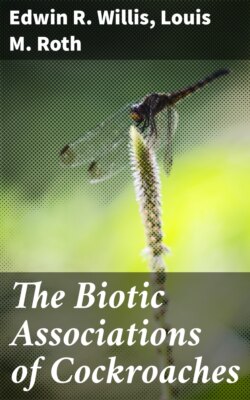Читать книгу The Biotic Associations of Cockroaches - Edwin R. Willis - Страница 403
На сайте Литреса книга снята с продажи.
SHIPS
ОглавлениеTable of Contents
Sailing ships have long been notorious for their unwelcome hordes of cockroaches, and it was by ship that at least 11 domiciliary species migrated from their centers of origin to other parts of the world (Rehn, 1945). Over 40 nondomiciliary species have been carried by ship from the American Tropics to other parts of the world in cargoes of bananas (p. 146). In addition to these, other adventive cockroaches appear from time to time in ports to which they have been carried by ships. Yet by far the most numerous cockroaches on shipboard are the breeding populations of a few common domiciliary pests. Except in the most rigorously disinsectized ships, this commerce in cockroaches has continued to the present day.
Cockroaches undoubtedly infested the first ships that sailed the Mediterranean; of these we have no records. The earliest recognizable record of cockroaches on shipboard is Moffett's (1634) statement that when Drake captured the ship Philip, he found it overrun with cockroaches [Blattarum alatarum]. Bligh (1792) described disinfesting H.M.S. Bounty with boiling water to kill cockroaches. Chamisso (1829) reported that he had seen ships casks, in which rice or grain had been stored, that were found to be filled with Blattella germanica when opened. During a voyage from England to Van Diemen's Land, Lewis (1836) was greatly annoyed by hundreds of cockroaches flying about his cabin at night; the most numerous resembled Periplaneta americana and another was similar to Ectobius lapponicus. This latter was undoubtedly B. germanica, which is the only ship-infesting species that resembles the feral E. lapponicus. Lewis continued, P. americana "were in immense profusion, and had communication with every part of the ship, between the timbers or skin. The ravages they committed on everything edible were very extensive; not a biscuit but was more or less polluted by them, and amongst the cargo 300 cases of cheeses, which had holes in them to prevent their sweating, were considerably damaged, some of them being half devoured and not one without some marks of their residence."
Kingsley (1870), Kellogg (1908), Gates (1912), Heiser (1936), and Bronson (1943) have all reported that cockroaches were so numerous on ships that they gnawed the skin and nails of the men on board. These are all independent observations of what may well have been a common occurrence on ships. We have discussed in detail the subject of cockroaches biting man in our 1957(a) paper.
Mosely (1892) reported, "At the time that England was left the ship [H.M.S. Challenger] seemed nearly free of animals, other than men, dogs, and livestock required for food. The first cockroaches apparently came on board at St. Vincent, Cape Verdes.... Cockroaches soon became plentiful on board, and showed themselves whenever the ship was in a warm climate.
"At one period of the voyage, a number of these insects established themselves in my cabin, and devoured parts of my boots, nibbling off all the margins of leather projecting beyond the seams on the upper leathers."
Sir Edmund Freemantle (1904) recalled some of his experiences in the British Navy. "Cockroaches in the tropics were also terrible scourges. One saw little of them in fine, dry weather, but in damp, wet weather they seemed to come from every hidden corner ... our remedy in the 'Spartan' was to make the boys catch them—on pain of being caned.... One brig, the 'Lily,' was so overrun by cockroaches that the officers' clothes smelt of them."
The quotation from Sonan (1924) on page 348 describes similar conditions in the Japanese Navy.
On modern cargo ships cockroaches are reported to be extremely numerous in the galley, the crew's quarters, and sometimes in the holds; they dwell in hot, humid environments such as the casing around steam pipes (Monro, 1951). Williams (1931) reported that Blattella germanica was the most important cockroach pest on ships seen at New York. Although often numerous in the holds, the cockroaches as a rule congregated in living quarters. They were also frequently found between tarpaulins covering the hatches. It was not unusual to kill 20,000 to 50,000 in the forecastle, and more than 20,000 have been taken from a single stateroom. Simanton (1946) inspected the S.S. William Kieth when it berthed at San Francisco from a 10-month voyage to the South Pacific. The holds were infested with thousands of Periplaneta americana, but in the crew's quarters, mess halls, and storerooms B. germanica predominated. After insecticidal treatment about 2,000 P. americana were seen in each hold and as many as 24 B. germanica in each cabin. Richardson (1947) reported that in Army transports inspected between 1943 and 1946 at New York, P. americana was found in the galleys and messes, and occasionally heavy infestations were found deep in the holds; B. germanica was found in the galleys and messes; Blatta orientalis was found only in the hold.
Additional references indicating the presence of Blattella germanica on ships may be found in the account of its parasite Ripidius pectinicornis (p. 232). Although Rice (1925) and Williams (1931) cite B. germanica as the most numerous cockroach on ships, Brooke (1920) stated that the great majority of ship cockroaches were Periplaneta americana. In addition to citing cockroach infestations on ships, the following authors reported various methods for disinfecting ships: Canalis (1916), Pryor (1918), Brooke (1920), Rice (1925), Williams (1931), Simanton (1946), Richardson (1947), and Anonymous (1951, 1954).
